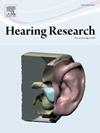Machine learning identification of tinnitus-related features in auditory peripheral spontaneous activity in a guinea pig noise-induced tinnitus model
IF 2.5
2区 医学
Q1 AUDIOLOGY & SPEECH-LANGUAGE PATHOLOGY
引用次数: 0
Abstract
Objectives
Tinnitus affects millions globally, yet its clinical assessment relies on subjective reports, limiting diagnostic accuracy and treatment development. This study aimed to identify objective, tinnitus-related features within ensemble spontaneous activity (ESA) recorded from the cochlear surface in a guinea pig model and to evaluate their reversibility using extracochlear electrical stimulation (EES) and machine learning.
Design
ESA was recorded from four groups: normal controls, noise-exposed animals with tinnitus, noise-exposed animals without tinnitus, and tinnitus animals after EES. Spectral features—central frequency, bandwidth, skewness, and kurtosis—were extracted using Fast-Fourier Transform and sliding window analysis. Behavioral tinnitus was assessed using the gap-prepulse inhibition of the acoustic startle reflex (GPIAS). Five machine learning models were trained to classify tinnitus status based on EES-reversible spectral features, with SHAP analysis used to identify key predictors.
Results
Tinnitus-related spectral alterations were observed in frequency bands associated with the exposure noise and its harmonic/subharmonic ranges. These changes were reversed by EES, coinciding with behavioral improvement in GPIAS. The support vector machine achieved the highest classification performance (AUC = 0.962). SHAP analysis identified central frequency (1400–1600 Hz) and skewness (8000–9000 Hz; 16,000–17,000 Hz) as the most informative features.
Conclusions
These findings suggest that specific ESA spectral features serve as objective and reversible biomarkers of tinnitus in a guinea pig model, offering potential for translation to clinical diagnostics and therapeutic monitoring.
机器学习识别豚鼠噪声诱发耳鸣模型听觉周围自发活动耳鸣相关特征
目的耳鸣影响全球数百万人,但其临床评估依赖于主观报告,限制了诊断的准确性和治疗的发展。本研究旨在确定豚鼠模型耳蜗表面记录的整体自发活动(ESA)中客观的耳鸣相关特征,并利用耳蜗外电刺激(EES)和机器学习评估其可逆性。设计esa记录四组:正常对照组、噪音暴露伴耳鸣动物、噪音暴露无耳鸣动物和EES后耳鸣动物。使用快速傅里叶变换和滑动窗口分析提取了频谱特征-中心频率,带宽,偏度和峰度。行为性耳鸣采用声惊反射间隙预脉冲抑制(GPIAS)进行评估。训练了五个机器学习模型,根据ees可逆光谱特征对耳鸣状态进行分类,并使用SHAP分析来识别关键预测因子。结果在暴露噪声及其谐波/次谐波范围相关的频带中观察到与耳鸣相关的频谱变化。EES逆转了这些变化,与GPIAS患者的行为改善相一致。支持向量机的分类性能最高(AUC = 0.962)。SHAP分析确定了中心频率(1400-1600 Hz)和偏度(8000-9000 Hz);16000 - 17000赫兹)作为最具信息量的特征。结论在豚鼠耳鸣模型中,特定的ESA光谱特征可作为耳鸣的客观、可逆的生物标志物,为临床诊断和治疗监测提供了潜在的应用价值。
本文章由计算机程序翻译,如有差异,请以英文原文为准。
求助全文
约1分钟内获得全文
求助全文
来源期刊

Hearing Research
医学-耳鼻喉科学
CiteScore
5.30
自引率
14.30%
发文量
163
审稿时长
75 days
期刊介绍:
The aim of the journal is to provide a forum for papers concerned with basic peripheral and central auditory mechanisms. Emphasis is on experimental and clinical studies, but theoretical and methodological papers will also be considered. The journal publishes original research papers, review and mini- review articles, rapid communications, method/protocol and perspective articles.
Papers submitted should deal with auditory anatomy, physiology, psychophysics, imaging, modeling and behavioural studies in animals and humans, as well as hearing aids and cochlear implants. Papers dealing with the vestibular system are also considered for publication. Papers on comparative aspects of hearing and on effects of drugs and environmental contaminants on hearing function will also be considered. Clinical papers will be accepted when they contribute to the understanding of normal and pathological hearing functions.
 求助内容:
求助内容: 应助结果提醒方式:
应助结果提醒方式:


